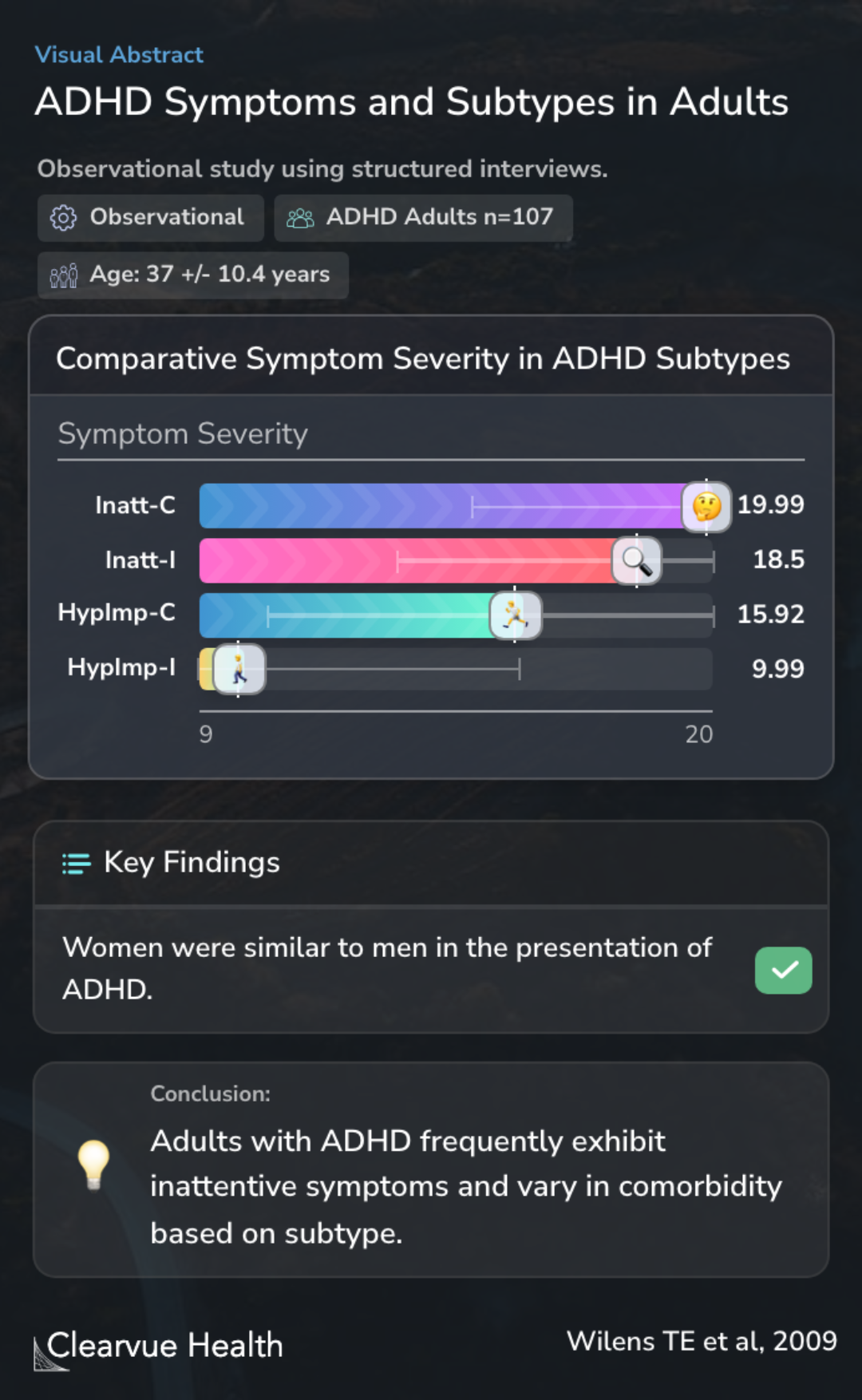Presenting ADHD symptoms, subtypes, and comorbid disorders in clinically referred adults with ADHD
ADHD Symptoms and Subtypes in Adults
Wilens TE, Biederman J, Faraone SV, Martelon M, Westerberg D, Spencer TJ

Objectives
The study aims to shed light on the presentation of attention-deficit/hyperactivity disorder (ADHD) in adults. Despite the growing awareness of ADHD in adults, many healthcare professionals are hesitant to assess individuals for this condition. This reluctance is partly due to limited data about how ADHD manifests in adulthood. Another key area of interest is the high rate of psychiatric comorbidity among adults with ADHD, which could lead to a more persistent form of the disorder.
Despite the increasing presentation of attention-deficit/hyperactivity disorder (ADHD) in adults, many practitioners remain reluctant to assess individuals for ADHD, in part related to the relative lack of data on the presenting symptoms of ADHD in adulthood. Comorbidity among adults wit...
Methods
In this study, 107 adults with ADHD were assessed using structured diagnostic interviews. The participants included both men and women (51% female), with an average age of around 37 years. The researchers used DSM-IV symptoms to determine the subtypes of ADHD. This observational study was conducted over a span of five years, from 1998 to 2003.
We assessed 107 adults with ADHD of both sexes (51% female; mean +/- SD of 37 +/- 10.4 years) using structured diagnostic interviews. Using DSM-IV symptoms, we determined DSM-IV subtypes. The study was conducted from 1998 to 2003.
Results
The study's findings offer a detailed view of the symptom patterns in adults with ADHD. A significant discovery was that inattentive symptoms were overwhelmingly common, reported by over 90% of the participants. This suggests that inattention is a predominant issue in adult ADHD, potentially impacting daily functioning and quality of life.
Moreover, the study revealed interesting nuances regarding psychiatric comorbidity. Adults with the combined subtype of ADHD were found to have relatively more psychiatric comorbidities compared to those with the predominantly inattentive subtype. This finding is crucial as it indicates a more complex clinical profile for the combined subtype, necessitating a comprehensive approach to treatment that addresses both ADHD symptoms and co-occurring psychiatric conditions.
Breaking down the data further, the study found that the distribution of ADHD subtypes in adults varied. The combined subtype, which includes both inattention and hyperactivity/impulsivity, was the most prevalent, accounting for 62% of the cases. This was followed by 31% of adults having the inattentive-only subtype, and a smaller portion, 7%, exhibiting the hyperactive/impulsive-only subtype. These percentages provide a clearer picture of how ADHD manifests differently in adults, underlining the importance of tailored approaches in diagnosis and treatment.
In terms of gender differences, the study observed that women and men exhibited similar patterns in the presentation of ADHD. This challenges some of the traditional perceptions about ADHD being more prevalent or severe in one gender over the other, suggesting that ADHD affects both men and women in comparable ways.
Inattentive symptoms were most frequently endorsed (> 90%) in adults with ADHD. Using current symptoms, 62% of adults had the combined subtype, 31% the inattentive only subtype, and 7% the hyperactive/impulsive only subtype. Adults with the combined subtype had relatively more psychiatri...
Conclusions
Adults with ADHD have prominent inattentive symptoms of ADHD, necessitating careful questioning of these symptoms when evaluating these individuals.
Key Takeaways
Context
Exploring the broader implications of ADHD in adults, the study by de Graaf et al. in 2008 provides essential context. It revealed that ADHD is not just a concern for the individual, but also has significant implications in the workplace. About 3.5% of the workforce is affected by ADHD, which translates to a substantial impact on productivity. For someone with ADHD, an estimated 22 days of productivity could be lost each year. This research highlights the broader economic and societal implications of adult ADHD, emphasizing the importance of effective management strategies, not only for improving individual health outcomes but also for enhancing workplace productivity.
Another critical dimension to the context is provided by the study from Knop et al. in 2009, which examined the long-term effects of ADHD, particularly in relation to conduct disorder and alcohol use in adulthood. This study found that boys with ADHD and conduct disorder are more likely to develop alcohol use disorders as adults. This longitudinal research underscores the potential for ADHD and associated disorders to have lasting consequences, further emphasizing the importance of early diagnosis and ongoing management strategies. These studies collectively underscore the multifaceted impact of ADHD in adults, extending beyond personal health to encompass broader societal and economic implications.